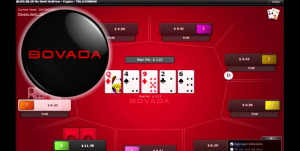Home » Poker » Texas Hold'em » Beginner's Guide
 Author:
Isaac Payne
| Last Updated:
July 2025
Author:
Isaac Payne
| Last Updated:
July 2025
Texas Hold’em is the world’s most popular poker game. Millions of players enjoy the simple format, fast-paced gameplay, and strategic depth of Texas Hold’em.
Elite players like Phil Ivey, Daniel Negreanu, and Justin Bonomo display remarkable levels of skill when playing Texas Hold’em. However, this poker variant is also perfect for beginners, as it’s simpler than Omaha and 7 Card Stud.
This guide explains how to play Texas Hold’em. We’ll break it down into a series of simple steps, and we’ll discuss the difference between Limit Hold’em, No Limit Hold’em, and Pot Limit Hold’em. Let’s get into it.
Texas Hold’em is a community card poker game. This is the basic format:
A round of Texas Hold’em can be divided into six steps: blinds, pre-flop, the flop, the turn, the river, and the final showdown. Here’s how a round unfolds:
Most Texas Hold’em games use blinds to stimulate the action. Blinds are forced bets, which you’re required to place when it’s your turn. At the start of each hand:
The big blind is usually double the size of the small blind. For example, the player to the left of the dealer might be required to lay a $5 chip on the table. The player sitting to the left of that player would then place a $10 chip on the table.
Note: If you play poker with your friends, the role of the dealer will rotate clockwise around the table after each hand. That means the players posting the small blind and large blind will also rotate with each round. When you play online, a dealer button indicates which player would be the dealer if the game were being played in a physical setting, so you know when it’s your turn to place the small blind or big blind.
When the blinds have been posted, each player will be dealt two-hole cards face down. You can examine your cards to gauge the strength of your hand.
The players then take it in turns to make their plays. You have three options at the pre-flop stage:
The player sitting to the left of the big blind begins. Betting continues in a clockwise pattern until all players have either folded or called the highest bet.
Three community cards are then dealt face up in the middle of the table. They are known as community cards, as each player can use them in conjunction with his or her unique hole cards to create a five-card poker hand.
Another round of betting then unfolds, starting with the player directly to the left of the dealer (small blind). You have five options:
The flop ends when all players have either folded or called the highest bet.
After the flop, one more community card is dealt face up on the table. This card is known as the turn, or the fourth street. Another round of betting then takes place.
When the turn has concluded, a fifth community card is dealt face up on the table. A final round of betting then takes place, giving each remaining player the chance to raise, call, or fold.
A showdown will occur if at least two players are still vying for the pot after the final round of betting. The players reveal their hole cards, and whoever has the best five-card hand wins the pot.
If two or more players have the same strength hand, the pot is split evenly among them. We’ve highlighted the Texas Hold’em hands below, ranked from high to low.
Texas Hold'em FormatsYou can play Texas Hold’em at all the leading poker rooms. The Texas Hold’em rules will be the same, but there are various formats to consider:
We’ve already explained the Texas Hold’em rules, but you also need to understand the different betting structures. There are three main formats:
The goal is to compile the best possible hand when you play Texas Hold’em. These are the different Texas Hold’em hands, ranked from best to worst:

Learning Texas Hold’em strategy for beginners can boost your chances of success. Here are 10 top tips to help you win:
Consult a starting hand guide. It will tell you which hands to play and which hands to fold, according to your position at the table. There are three positions:

For example, you should always play premium hands like AA, KK, QQ, JJ, TT, AK, or a suited AQ, regardless of where you’re sitting.
Meanwhile, hands like AJ, AT, KJ, KT, QJ are often worth playing in a middle or late position on the table. Hands like Q9, J8, or T7 might look tempting, but they’re often best avoided, especially when you’re in an early position.
You’re likely to lose if you play every hand. Stick to strong starting hands, such as big pairs (AA, KK, QQ), high cards (AK, AQ), and suited connectors (suited JT).
Learn to play aggressively at the right times. Raise instead of just calling, as this will pile pressure on your opponents.
Make your betting decisions according to your position at the table. The earlier you act in a hand, the more cautious you should be.

Early position: Play tight, which means play with caution. You might end up playing around 15-20% of hands in an early position.
Middle position: You can loosen up a little when you’re in a middle position, but it’s best to still err on the side of caution. You might decide to play around 25% of hands in a middle position.
Late position: You have a major advantage, as you can see how your opponents have acted. It allows you to control the pot, bluff more effectively, and make more informed decisions. You could play approximately 35-40% of hands in a late position.
Here’s an example of how you might play the same hand differently depending on where you’re positioned at the table:
| Hand | Early Position | Late Position |
|---|---|---|
| AQ off-suit | Raise or fold | Raise or call |
| 77 | Call or fold | Raise or call |
| 98 suited | Fold | Raise or call |
| QJ off-suit | Fold | Raise if folded to you |
If you’re unsure, it’s okay to fold. Weak hands occasionally win, but they often lose. Focus on quality over quantity, especially when you’re learning how to play Texas Hold’em.
Pot odds tell you whether it would be beneficial to call, based on the size of the pot and the amount you’d need to risk. This is the formula:
It looks complex, but it’s actually pretty simple. For example, let’s say there’s $100 in the pot. Your opponent bets $20, taking the pot total to $120. That means you need to bet $20 in a bid to win $120. If you calculate that your chances of winning are better than 1 in 6, it’s worth risking $20 to try.
Here’s a basic way to approach it:
Positive EV: Only call bets when your odds of winning are better than the price you’re paying. That means you have a positive expected value (EV).
Negative EV: If the bet feels expensive, and you’re just hoping to get lucky, fold. The odds of success are lower than the price you’re paying, so the bet has a negative EV.
A draw in poker refers to a hand that is not yet complete. It requires further cards to turn it into a strong hand.
For example, you might need one more card to complete a straight or a flush. If so, consider the odds of the right card being drawn. Don’t simply call large bets when hoping for one more card unless the math justifies it.
Consider how many cards are left in the pack, and work out the probability of the right card being dealt. Only call if your odds of winning are higher than the pot odds. If not, fold.
Here’s a simple rule of thumb for beginners: if it’s a big bet, and you need one card to complete a straight or flush, fold unless it’s cheap to call.
Bluffing is a key skill to develop when you learn Texas Hold’em strategy. It’s exciting to fool your opponents and win a pot with a weak hand, but you should only bluff when it makes sense.
A successful bluff should tell a believable story. Beginners often bluff too often, or they bluff at the wrong time.
You’ll seriously improve your chances of success by watching how your opponents play. There are four main styles:
Figuring out which types of players you’re up against can help you tweak your strategy, allowing you to counter their strengths and exploit their weaknesses.
Only play Texas Hold’em with money you can afford to lose. Start out by placing small bets, and don’t move up in stakes too quickly while you’re learning the ropes.
Some players make emotional decisions after losing. This causes them to pursue a suboptimal strategy, as they’re angry or frustrated. They may play too many hands, bet in an overly aggressive manner, or chase losses. This emotional state of confusion is known as tilt, and successful players learn how to avoid it.
The best Texas Hold’em players have a long-term mindset. They know they can’t win every hand or session. Learn from them by displaying patience and discipline when playing Texas Hold’em.
Fold often, stay calm, wait for profitable spots, and capitalize upon them. Learn to spot tilt in your opponents, and try to exploit it.
Sharpen your skills by playing Texas Hold’em for free. There are a few options:
You can then switch to playing Texas Hold’em for real money when you feel confident.
Where to Play Texas Hold'em OnlineThese are the best sites to play Texas Hold’em online:

Bovada is the busiest online poker room in North America. It offers greater liquidity and higher traffic than any rival sites, and it guarantees $2 million in weekly prize pools. You can compete in a busy schedule of Texas Hold’em tournaments and cash games at Bovada.
Sign up at Bovada
BetOnline allows you to compete in a wide array of Texas Hold’em tournaments and cash games, with broad betting limits. The site also offers a wealth of bonuses, including a 100% poker welcome bonus, weekly leaderboards and bad beat jackpots. You can also play poker games against the house at BetOnline.
Sign up at BetOnline
Everygame is a great place to play Texas Hold’em for beginners. This established site hosts regular freerolls, so you can sharpen your skills without risking any money. You can also win prizes, such as bonus credits or free spins for the online casino. There are plenty of Texas Hold’em tournaments and cash games too, and Everygame also offers a market leading 36% rakeback rate.
Sign up at EverygameYou can download free apps or visit free sites, which help you master Texas Hold’em. Here are some options:
We’ve explained how to play Texas Hold’em for beginners. It’s now time for you to put your knowledge to the test. You can hone your skills by competing in freeroll tournaments at elite online poker rooms like Everygame, BetOnline, and Bovada.
You’ll soon learn when to play tight and when to bet more aggressively. If you learn to keep your emotions in check, and you manage to exploit your rivals’ emotions, you can enjoy great success when playing Texas Hold’em. Visit one of our recommended poker sites to claim your welcome bonus, and you can then start playing Texas Hold’em right away.

Isaac E. Payne is an experienced technical blogger, creative writer, and lead content manager at GamblingNerd.com. As a published author, he enjoys finding interesting and exciting ways to cover any topic. In his four years on the team, he has covered online gambling and sports betting and excelled at reviewing casino sites. In his free time, he enjoys playing blackjack and reading science fiction.

